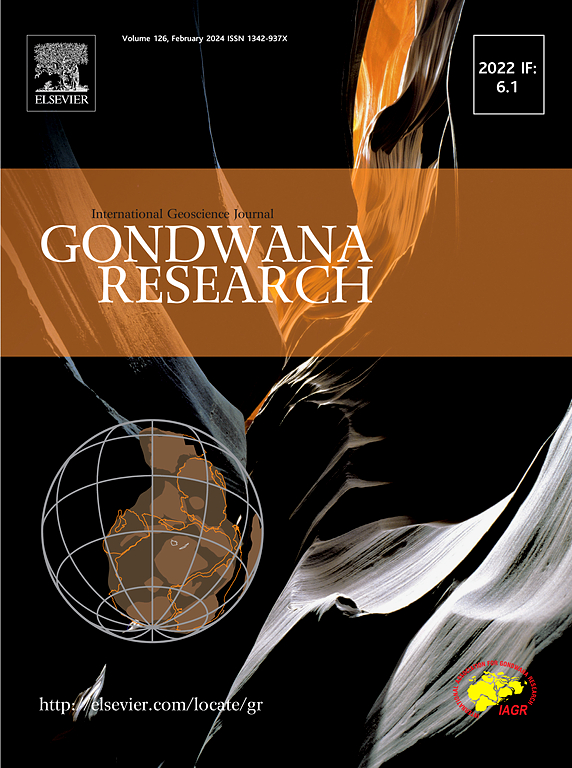阿尔泰山红流河-西昌井弧后洋威尔逊旋回及其对地壳改造的贡献
IF 7.2
1区 地球科学
Q1 GEOSCIENCES, MULTIDISCIPLINARY
引用次数: 0
摘要
弧后盆地作为增生造山带内洋壳生成的主要场所,在地壳改造中起着至关重要的作用。然而,弧后盆地如何促进地壳改造仍然是个谜。红柳河-西长井洋(HXO)作为古亚洲洋早古生代的一个重要分支,其形成和关闭的时间和过程引起了相当大的争论。本研究基于沿其边缘的两个增生复合体的沉积序列和物源,提出了HXO的威尔逊旋回。南缘寒武—早奥陶世碎屑锆石年龄谱为双峰型,峰值分别为980和2440 Ma左右,来源于敦煌和双鹰山地块。晚奥陶世地层年龄谱为单峰型,年龄峰在472 ~ 458 Ma,来源于双鹰山地块的一个幼年弧。北缘寒武系地层年龄谱为双峰型,年龄峰值分别为558 Ma和671 Ma,来源于图瓦—蒙古地块附近的火山弧。志留系年龄谱在441 ~ 451 Ma左右转变为单峰型,表明其来源于宫坡泉弧。寒武纪两缘物源区域的差异表明了HXO的存在,而从寒武纪到中晚奥陶世的物源转移则表明它们都是从被动边缘向活动大陆边缘转变的。威尔逊旋回包括早寒武世弧后扩张、中寒武世至早奥陶世的海洋伸展和中奥陶世至晚石炭世的两极俯冲。HXO的形成及其后弧后扩张是其双极俯冲使均匀大陆破碎的结果,是阿尔泰地区地壳改造的重要机制。HXO的复活俯冲产生了增生复合体,导致了地壳的横向生长。本文章由计算机程序翻译,如有差异,请以英文原文为准。

The Wilson cycle of the Hongliuhe-Xichangjing backarc ocean in the Altaids and its contribution to crustal reworking
Backarc basins, as primary sites for oceanic crust generation within accretionary orogen, play a critical role in crustal reworking. However, it remains enigmatic how backarc basins contribute to crustal reworking. The Hongliuhe–Xichangjing Ocean (HXO), as a significant Early Paleozoic branch of the Paleo-Asian Ocean, has sparked considerable debate regarding the timing and processes of its formation and closure. This study proposes a Wilson cycle for the HXO, based on sedimentary sequences and provenances from two accretionary complexes along its margins. On the southern margin, the detrital zircon age spectra of Cambrian to Early Ordovician strata are bimodal with age peaks at ca. 980 and 2440 Ma derived from the Dunhuang and Shuangyingshan blocks. The age spectra of Late Ordovician strata are unimodal with age peaks at 472–458 Ma, showing derivation from a juvenile arc on the Shuangyingshan block. On the northern margin, the age spectra of Cambrian strata are bimodal with the age peaks at 558 Ma and 671 Ma sourced from volcanic arcs near the Tuva-Mongolia block. In the Silurian, the age spectra shift to unimodal pattern with age peaks at ca. 441–451 Ma, showing their derivations from the Gongpoquan arc. The differences in source areas of both margins in the Cambrian indicate the existence of HXO, while the provenance shift from Cambrian to Middle-Late Ordovician reveals that they both transformed from passive margins to active continental margins. The Wilson cycle involves backarc spreading during the Early Cambrian, oceanic extension from the Middle Cambrian to Early Ordovician and bipolar subduction from the Middle Ordovician to Late Carboniferous. The formation of HXO and subsequent backarc expansion resulted from its bipolar subduction fragmented the uniform continent, which is a key mechanism for crustal reworking in the Altaids. Resurrected subduction of the HXO produced accretionary complexes, leading to lateral crustal growth.
求助全文
通过发布文献求助,成功后即可免费获取论文全文。
去求助
来源期刊

Gondwana Research
地学-地球科学综合
CiteScore
12.90
自引率
6.60%
发文量
298
审稿时长
65 days
期刊介绍:
Gondwana Research (GR) is an International Journal aimed to promote high quality research publications on all topics related to solid Earth, particularly with reference to the origin and evolution of continents, continental assemblies and their resources. GR is an "all earth science" journal with no restrictions on geological time, terrane or theme and covers a wide spectrum of topics in geosciences such as geology, geomorphology, palaeontology, structure, petrology, geochemistry, stable isotopes, geochronology, economic geology, exploration geology, engineering geology, geophysics, and environmental geology among other themes, and provides an appropriate forum to integrate studies from different disciplines and different terrains. In addition to regular articles and thematic issues, the journal invites high profile state-of-the-art reviews on thrust area topics for its column, ''GR FOCUS''. Focus articles include short biographies and photographs of the authors. Short articles (within ten printed pages) for rapid publication reporting important discoveries or innovative models of global interest will be considered under the category ''GR LETTERS''.
 求助内容:
求助内容: 应助结果提醒方式:
应助结果提醒方式:


